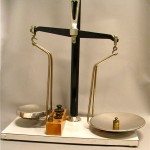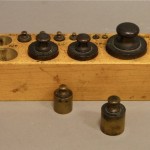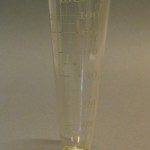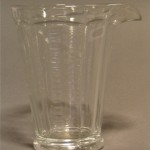Weights and Measures
The pharmacist spent a good deal of time in measuring quantities of chemicals by weight and by volume. Until the late 20th century pharmacists were very conservative in their use of old-fashioned systems of measurement. As well as familiar pounds and ounces, pints and fluid ounces they used less familiar units, passed on from the old days of apothecaries, for measuring very small quantities. Drams (or drachms) were 1/6 of an ounce (1/96 pound) on the apothecary’s scale or = 3 scruples, or 60 grains. For fluids one minim = 1/480 of a fluid ounce (20 fluid ounces to the pint).
Click on the thumbnail pictures for a bigger view.
 These are the largest of the balance scales in the Museum’s chemist shop. They balance on a knife-edge to reduce friction. We keep a weight on one side to prevent too much movement that would wear the knife-edge. A weights and measures inspector would have expected to find the shop had done this.
These are the largest of the balance scales in the Museum’s chemist shop. They balance on a knife-edge to reduce friction. We keep a weight on one side to prevent too much movement that would wear the knife-edge. A weights and measures inspector would have expected to find the shop had done this.
.
.
.
 The set of weights that was used with the balance. The weights are made of a copper alloy and run from xxx to 400 grammes.
The set of weights that was used with the balance. The weights are made of a copper alloy and run from xxx to 400 grammes.
.
.
Glass measuring jugs (below) come in many sizes for different jobs and are in metric and imperial measurements.
.
.
An R.T. Christopher measuring glass and its protective case. It was meant for use by the patient or carer to measure doses, so the measurements are in spoonfuls (a teaspoon was defined as 1.5 fluid drams).




